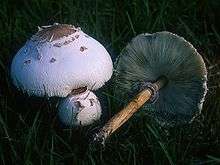Chlorophyllum molybdites
| Green-spored parasol Chlorophyllum molybdites | |
|---|---|
 | |
| Chlorophyllum molybdites | |
| Scientific classification | |
| Kingdom: | Fungi |
| Division: | Basidiomycota |
| Class: | Agaricomycetes |
| Subclass: | Homobasidiomycetidae |
| Order: | Agaricales |
| Family: | Agaricaceae |
| Genus: | Chlorophyllum |
| Species: | C. molybdites |
| Binomial name | |
| Chlorophyllum molybdites (G. Mey.) Massee (1898) | |
| Synonyms | |
|
Agaricus molybdites | |
| Chlorophyllum molybdites | |
|---|---|
|
| |
| gills on hymenium | |
| cap is flat | |
| hymenium is free | |
| stipe has a ring | |
| spore print is green | |
| ecology is saprotrophic | |
| edibility: poisonous | |
Chlorophyllum molybdites, which has the common names of false parasol or green-spored parasol, is a widespread mushroom. Highly poisonous and producing severe gastrointestinal symptoms of vomiting and diarrhea, it is commonly confused with the shaggy parasol, and is the most commonly consumed poisonous mushroom in North America.[1] Its large imposing appearance and similarity to the edible parasol mushroom, as well as its habit of growing in areas near human habitation, are reasons cited for this. The nature of the poisoning is predominantly gastrointestinal.
Distribution and habitat
Chlorophyllum molybdites grows in lawns and parks across eastern North America and California, as well as temperate and subtropical regions around the world.[2] Fruiting bodies generally appear after summer and autumn rains. It appears to have spread to other countries, with reports from Scotland, Australia, and Cyprus.[3]
Description
It is an imposing mushroom with a pileus (cap) up to 40 cm in diameter, hemispherical and with a flattened top. The cap is whitish in colour with coarse brownish scales. The gills are free and white, usually turning dark and green with maturity. Spore print is green. The tall stipe may be up to 25 cm tall and bears a ring. This mushroom lacks the snakeskin pattern that is generally present on the parasol mushroom.[4]
Toxicity
Chlorophyllum molybdites is the poisonous mushroom most frequently eaten in North America.[1] The symptoms are predominantly gastrointestinal in nature, with vomiting, diarrhea and colic, often severe, occurring 1–3 hours after consumption.[2] Although these poisonings can be severe, none has yet resulted in death.[5]
Gallery
 In Osaka
In Osaka Chlorophyllum molybdites
Chlorophyllum molybdites Chlorophyllum molybdites
Chlorophyllum molybdites Chlorophyllum molybdites
Chlorophyllum molybdites- A young false parasol mushroom
 Chlorophyllum molybdites spore print showing its green color
Chlorophyllum molybdites spore print showing its green color
References
- 1 2 Beug, Michael W. An Overview of Mushroom Poisonings in North America. The Mycophile, vol. 45(2):4-5, March/April 2004
- 1 2 Benjamin, Denis R. (1995). "Gastrointestinal syndrome". Mushrooms: poisons and panaceas — a handbook for naturalists, mycologists and physicians. New York: WH Freeman and Company. pp. 351–377. ISBN 0-7167-2600-9.
- ↑ Loizides M, Kyriakou T, Tziakouris A. (2011). Edible & Toxic Fungi of Cyprus (in Greek and English). Published by the authors. pp. 132–33. ISBN 978-9963-7380-0-7.
- ↑ How to not pass up a parasol – and how not to
- ↑ "Chlorophyllum molybdites". Urban Mushrooms.
External links
- Mushroom Expert – Chlorophyllum molybdites
- Tom Volk's Fungus of the Month – Chlorophyllim molybdites
| Wikimedia Commons has media related to Chlorophyllum molybdites. |
